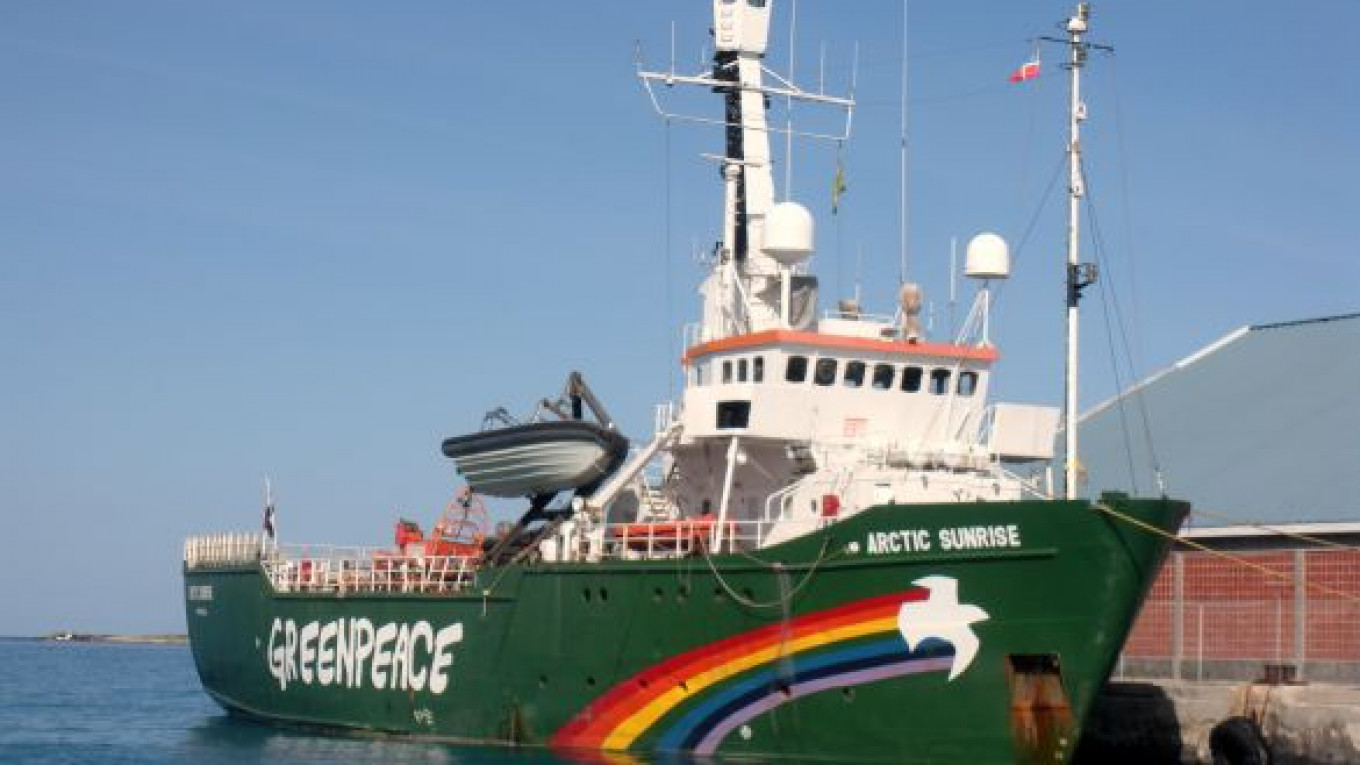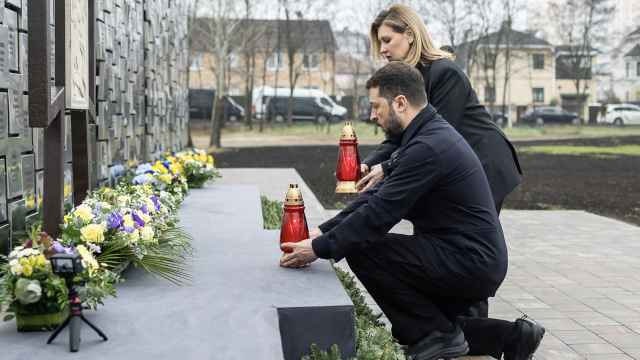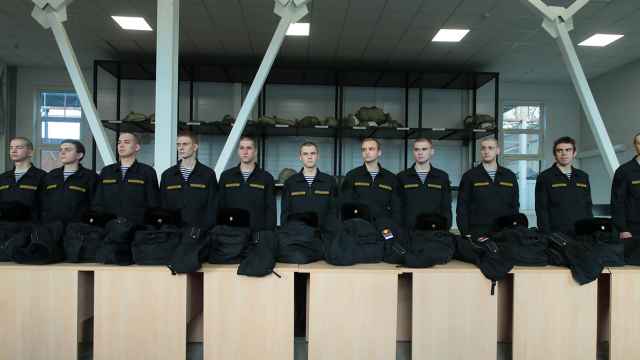ON BOARD THE Arctic SUNRISE, The Barents Sea — Each morning at about 9:30, an Illyushin-38 patrol aircraft zooms in from the aft, circles once and then flies off back south.
It is clear to the crew of this Greenpeace vessel in the middle of the Barents Sea, that the Russian Navy is keeping a close eye on their movements.
Lunch on the first day out of Murmansk, prepared by the ship's talented Mexican cook, was slightly overshadowed by an ever-present gray speck on the horizon, a Russian destroyer that had apparently shadowed the Greenpeace vessel from port.
Not that Vladimir Votiakov, the Russian-born captain of the Arctic Sunrise is concerned by the attention.
"It could be routine, but I'm sure they're having a look at us, too," he said.
The reason for such vigilance is clear. The Greenpeace vessel, a veteran of numerous direct-action campaigns by the group, is headed east across the Barents Sea, and from its deck one can now just make out a tiny white pyramid on the horizon.
It is the drilling tower of the Prirazlomnoye oil platform, Russia's first Arctic oil rig and a flagship for a drive for Arctic oil and gas that Vladimir Putin has said is key to the country's future.
It's an appropriate mission for the Sunrise, a scruffy but tough icebreaker originally built to supply Norwegian oil rigs in the North Sea.
The U.S. Geological Survey has estimated that there is 1.5 billion tons of oil, 11 trillion cubic meters of natural gas and 270 million tons of natural-gas liquids beneath the Barents Sea, mostly in Russia's exclusive economic zone.
Prirazlomnoye is just one of dozens of such fields in the Pechora Sea, a shallow bay of the Barents just south of the Novaya Zemlya islands.
Greenpeace argues that the development of the fields not only jeopardizes the Arctic ecosystem but is also costly, economically unviable and unnecessary.
The group says Russia could significantly increase its oil production by slashing the estimated 5 million tons it loses annually through leaky pipes.
Activists also point to the fate of the Kolskaya platform, which sank in the Sea of Okhotsk in December and took 53 lives, as evidence of a lax safety culture that they say will put both the platform's crew and the local environment at risk.
Russia is not alone in its dash for the Arctic. While Rosneft and Gazprom invade the Barents, European oil and gas firms are nosing around Greenland, where last year Greenpeace activists occupied an exploration rig belonging to Cairn Energy off the Arctic island.
But this is the first time in 20 years that the environmental group has entered Russian Arctic waters, and the activists are not entirely sure how the mission will turn out when they arrive at the platform late Thursday or early Friday.
The activists on board say that this is strictly a fact-finding mission and that there will be none of the occupations or other stunts that the group has pulled elsewhere.
"We just want to take a look [at the platform]. No one has seen it," said Al Baker, an international action logistics coordinator for Greenpeace International. "We're going to ask them if we can come on board, have a cup of tea and explain our position."
"But we may come back and do something in the future," he added with a wink.
A veteran of numerous actions, from the French nuclear testing sites in the Pacific to the occupation of the Brent Spa rig in the North Sea, Baker would not elaborate on any future plans.
Frosty Welcome
The last time Greenpeace sent one of its vessels to these waters was in 1992. Its team visited Murmansk before illegally landing on Novaya Zemlya, part of which was then a nuclear testing ground.
Although the activists were promptly arrested after the landing, Yevgenia Belyakova, the coordinator of Greenpeace Russia's Arctic program, said the reception was much warmer 20 years ago.
On this return voyage, the Arctic Sunrise had to navigate a former World War II minefield to enter and leave Kola Bay, the long fjord that serves as Murmansk's harbor.
Officially, the area has been cleared, but it is still best to keep to the marked channel. But the wartime relics and the 300-odd wrecks that have sunk in the bay are nothing compared with the bureaucratic hassles the activist group faced in organizing this trip.
"Never in my career have I encountered that level of obstructiveness," said Votiakov, a career seafarer and graduate of the Odessa maritime academy. "It was just clear we were not welcome."
It took an appeal by Greenpeace International's director to President Vladimir Putin and a subsequent phone call from the presidential administration to persuade the port authorities to let the Arctic Sunrise in.
Even then, the port authorities refused to allow the vessel a dockside berth and instead gave an anchorage in the bay a full 45 minutes by motorboat from the quay.
The ship was subjected to an inspection by customs officials of a kind Votiakov said he had never experienced before.
"I think they didn't really understand why we were there. They thought we were going to do some kind of action and cause them a headache," he said.
The Barents Sea was calm and empty on Thursday afternoon, with nothing to be seen but sea, sky and, on the southern horizon, an ice-class tanker on its way to LUKoil's export terminal at Varandei, where a pipeline carries oil from northern fields out to ships.
What happens when the Arctic Sunrise arrives at Prirazlomnoye on Thursday evening or early Friday is anyone's guess. Normally Greenpeace activists call ahead to give their targets warning before they launch one of their actions, largely for safety reasons.
Jumping over a fence into a nuclear power station can get "messy" if the security guards don't know whom you are, Baker said.
But since this voyage is meant to do only reconnaissance, crew members have not warned Gazprom. Instead they will simply ask if they can come on board once they approach the platform.
Most of the world has never seen the drilling rig except in Gazprom press releases. The Federal Border Guards service told the ship's agent in Murmansk that there is a 12 nautical mile exclusion zone around the Prirazlomnoye platform, in which case it could remain unseen.
The normal safety exclusion zone around a rig or platform is 500 meters, while the British Admiralty chart on board the Arctic Sunrise shows a recommended 3 nautical mile safety zone.
Consensus seems to be to follow the chart and ask for permission to enter to the 500-meter zone.
There is, the activists admit, a chance "they may consider our presence threatening enough to board us."
The tactics to be followed in that situation are to "ask them to leave their guns behind" and "be polite."
A Message from The Moscow Times:
Dear readers,
We are facing unprecedented challenges. Russia's Prosecutor General's Office has designated The Moscow Times as an "undesirable" organization, criminalizing our work and putting our staff at risk of prosecution. This follows our earlier unjust labeling as a "foreign agent."
These actions are direct attempts to silence independent journalism in Russia. The authorities claim our work "discredits the decisions of the Russian leadership." We see things differently: we strive to provide accurate, unbiased reporting on Russia.
We, the journalists of The Moscow Times, refuse to be silenced. But to continue our work, we need your help.
Your support, no matter how small, makes a world of difference. If you can, please support us monthly starting from just $2. It's quick to set up, and every contribution makes a significant impact.
By supporting The Moscow Times, you're defending open, independent journalism in the face of repression. Thank you for standing with us.
Remind me later.






